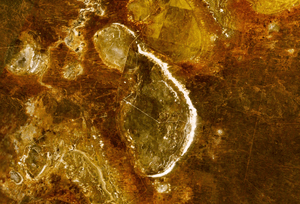Lake Mungo facts for kids
Lake Mungo is a dry lake in the south-western part of New South Wales, Australia. It is about 760 km west of Sydney and 90 km north-east of Mildura. This lake is the main part of Mungo National Park. It is also one of 17 lakes in the Willandra Lakes Region, which is a special World Heritage Site.
Many important discoveries about ancient humans have been made at Lake Mungo. These include Mungo Man, who is the oldest human found in Australia. Also found was Mungo Lady, the oldest human in the world known to have been ritually cremated.
Contents
What is Lake Mungo?
Lake Mungo is not a wet lake anymore. It dried up thousands of years ago. The land around it has layers of sand and soil. These layers tell us about the past.
On the eastern side of the lake, there are big sand dunes called the 'Walls of China'. These dunes are about 26 km long and 30 metres high. They were formed over many thousands of years.
There are three main layers of sand and soil in the Walls of China:
- The oldest layer is reddish. It is called the Gol Gol layer. It formed between 100,000 and 120,000 years ago.
- The middle layer is greyish. It is called the Mungo layer. This layer was laid down between 50,000 and 25,000 years ago.
- The newest layer is pale brown. It is called the Zanci layer. It formed between 25,000 and 15,000 years ago.
The Mungo layer is the most important for finding ancient things. This was before the last ice age. Even though there was not much rain, the lake stayed full. This was because water flowed from the western side of the Great Dividing Range. Many people and large animals, called Australian megafauna, lived here then.
During the last ice age, the lake's water level dropped. It became a salt lake. The soil became alkaline, which helped to keep ancient remains safe. Even after the lake dried up, plants grew on the Walls. These plants helped to keep the dunes stable.
When European settlers arrived in the 1880s, they brought animals like rabbits, sheep and goats. These animals ate the plants. This caused the dunes to wear away, a process called erosion. But this erosion also helped to uncover many human and animal remains.
Ancient Discoveries at Lake Mungo
The most important finds at Lake Mungo are Mungo Man and Mungo Lady.
Mungo Lady
Mungo Lady was found in 1969 by Dr Jim Bowler. She was a body that had been partly cremated. At first, scientists thought she was 25,000 years old. Later studies in 2003 showed she was probably closer to 40,000 years old. Mungo Lady is the earliest known human to have been cremated.
Mungo Man
Mungo Man was also found by Dr Bowler, in 1974. His remains were covered with red ochre. This is the earliest known example of a burial like this. Some studies suggested he was over 60,000 years old. But most scientists now agree he is also about 40,000 years old.
Other Ancient Finds
Humans have lived around Lake Mungo for at least 50,000 years. Scientists have found stone tools in the dunes that are even older than Mungo Man.
Grinders used for making flour have been found. These are between 5,000 and 10,000 years old. They were made from sandstone that came from the Murray River basin, about 100 km away.
A stone axe head, at least 500 years old, was also found. It was made from stone from Mount Camel, near Shepparton. This place is over 300 km away! This shows that ancient people traded or traveled long distances.
Importance to Aboriginal People
The ancient history of Lake Mungo is very important to the Aboriginal Australian people. The Willandra region is the home of the Barkindji, Nyiampaa and Mutthi Mutthi people. They work with the Government of New South Wales to manage the lake and Mungo National Park. This is part of special Joint Management Agreements.
Lake Mungo's Magnetic Mystery
In 1972, scientists studied ancient Aboriginal fireplaces at Lake Mungo. They looked at the magnetism in the baked stones from these fires. They found that the Earth's magnetic field moved a lot about 30,000 years ago. This big shift is called a geomagnetic excursion.
Before Lake Mungo, scientists thought these magnetic shifts might just be due to how dirt settled. But the Lake Mungo findings showed that the Earth's magnetic field itself really moved. This was a big discovery!
Other studies in Norway and France found similar magnetic shifts around the same time. This suggests that the Lake Mungo magnetic event was a global event, not just something local.
Images for kids
See also
 In Spanish: Lago Mungo para niños
In Spanish: Lago Mungo para niños




